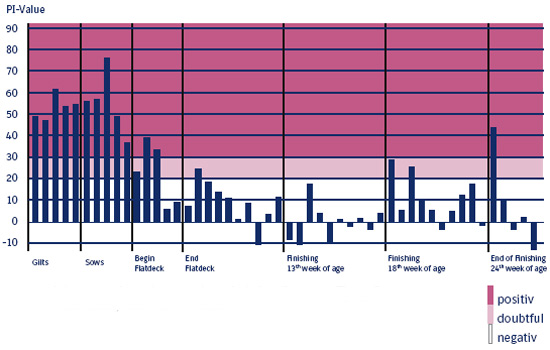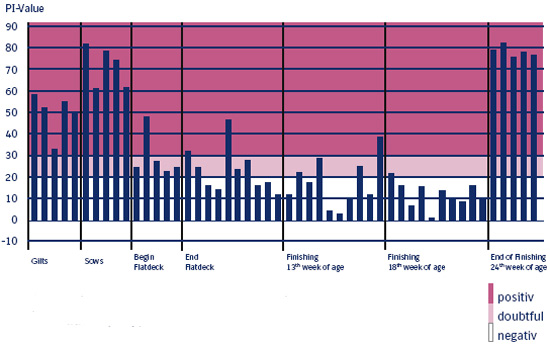6.3 What is the reason for failure of antibiotic treatment to control Ileitis?
Occasionally, some of the drugs mentioned, such as tylosin, are used against Ileitis in farm outbreaks, but do not seem to be fully effective. Sometimes, this is interpreted as Lawsonia intracellularis becoming “resistant” to the drug. Investigation of these situations usually reveals that either:
* The pigs were under dosed. For example, older larger pigs were given inadequate in-feed amounts to make up their bodyweight dose. This is most commonly seen in sows in hot weather, which eat below normal feed intakes.
* The pigs had some other disease or nutrition problem.
* The antibiotic was administered too late to be effective in preventing intestinal damage.

Figure 6.3 a
Efficient Treatment. Antibiotic Treatment in the Period from the 10th to the 19th week of age.
Antibiotic treatment has an impact on the serological profile of a farm. The profile above demonstrates, that the serologic reaction can be suppressed completely by an efficient antibiotic treatment.
Another common problem is that pigs which are maintained clean by the use of antibiotics can develop acute proliferative enteropathy after withdrawal of the treatment. It is clear in these situations that the medicated pigs are not getting the chance to develop active immunity to the disease, but remain naïve and susceptible. Older pigs are more likely to get acute proliferative enteropathy, so this strategy presents a great danger when gilts and other animals are kept on antibiotics.

Figure 6.3 b
Discontinued Treatment. Antibiotic Treatment in the Period from the
10th to the 13th week of age.
In this example the antibiotic treatment was discontinued after the 13th week of age. As a result, the pigs remained negative until 18 weeks of age but the samples were completely positive by the 24th week of age.
© Boehringer Ingelheim Animal Health GmbH, 2006
All rights reserved. No part of this Technical Manual 3.0 may be reproduced or transmitted in any form or by any means, electronic or photocopy, without permission in writing from Boehringer Ingelheim Animal Health GmbH.






